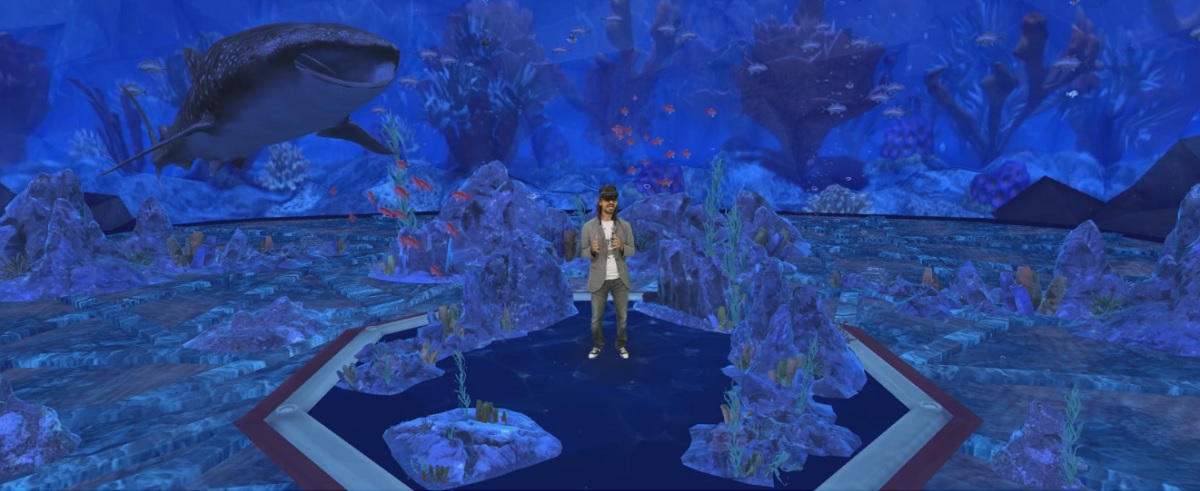What is Holoportation in Microsoft Mesh Mixed Reality Platform?

Recently updated on November 14th, 2021 at 02:40 am
If you can remember in year 2020, there is a viral where a boss accidentally turned herself into a “potato” during the entire online meeting because she accidentally turn on a filter during the session. Perhaps, this kind of incident will be less likely to happen with the new advancement in virtual meeting technology.
 |
Recently, during the Microsoft Ignite 2021 conference keynote, Microsoft has announced their new mixed reality products called “Microsoft Mesh“. One of the coolest stuff during the event is when they introduce an impressive holograms capability called “Holoportation“. The way how they run the key note is very impressive. Hard for the future key note speaker to beat that level on the virtual stage!
So, what is Microsoft Mesh?
Microsoft Mesh is a mixed reality (MR) platform that enables collaboration among people from different physical locations. This is further enhanced with the use of holographic experiences during the collaboration. The best way to access this platform is by using HoloLens 2 or VR headsets such as HTC Vive Cosmos or HP Reverb G2. Just to add, this platform is powered by Microsoft Azure which is the Microsoft’s cloud computing platform. In a whole, this is something like Microsoft Teams on steroid.
During the keynote conducted in AltspaceVR, Alex Kipman, who is the Technical Fellow AI & Mixed Reality of Microsoft, showcased the Microsoft Mesh capabilities. And one of its powerful features is the holoportation capability.
What is Holoportation in Microsoft Mesh?
Holoportation is the use of 3D capture technology to beam a lifelike image of a person into a virtual scene. With this capability, you can project yourself as your most lifelike, photorealistic self in mixed reality. Thus, you can interact as if you are there in person. Perhaps, in a simple word, it is a real-time hologram.
During the Microsoft Ignite 2021 conference keynote, we can see Alex Kipman appeared on the virtual stage in his full, real life body form. Like in the first picture above. Meanwhile, all the audiences in front of him were in the usual 3D cartoon style avatar form. This is a far cry and a very large jump from the current use of cartoonish avatars inside the virtual social media platforms. You can see how the situation looks like in picture below…
What’s the Benefit of Holoportation?
By using this holographic approach, the element of presence is brought up to another level where the user can now feel like they are really in the same place together with their partner, team or family. In the future, people will more likely to use this holoportation capability to project themselves in their lifelike, photorealistic form.
I mean, this kind of real life looking avatar is much more meaningful and useful when we are in a very serious meeting or discussion with our bosses, team, partners or clients. You can watch and gauge their body language, gestures and facial expression to plan for your next move during negotiation or discussion.
If we are still using the current 3D cartoon avatar’s style like today, I think most of the time, we would ridicule each other a lot during the meeting. Similar like the real cases where the bosses or teachers accidentally use the potato or cat filter on their avatar during the meeting or teaching.
Anyway, Microsoft Mesh still allow you to use the normal 3D avatar where you can customize it according to your preference. You can watch the video here to better understand about Microsoft Mesh…
Very impressive, isn’t it? For Alex Kipman, this kind of solution has been a dream for mixed reality since the beginning. This is the result of the continuous effort from Microsoft research and development to create persistent holograms. For more information about the Holoportation in Microsoft Mesh, you can read it at:
- The official Microsoft Mesh website.
- “You can actually feel like you’re in the same place: Microsoft Mesh powers shared experiences in mixed reality” from Microsoft’s Innovation Stories.
- Microsoft Mesh – A Technical Overview

